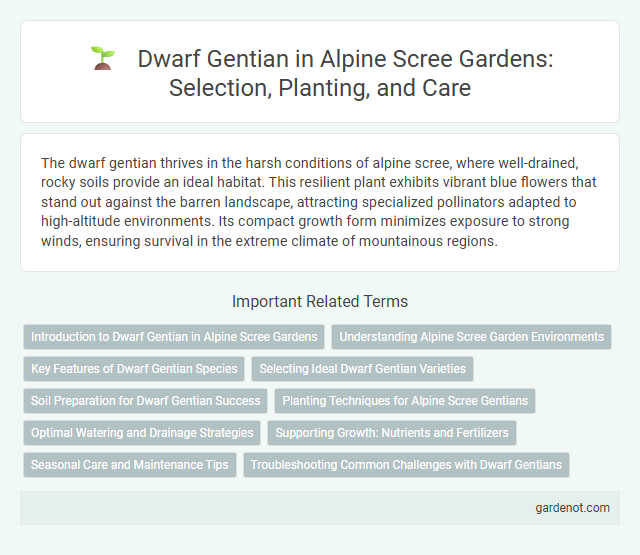The dwarf gentian thrives in the harsh conditions of alpine scree, where well-drained, rocky soils provide an ideal habitat. This resilient plant exhibits vibrant blue flowers that stand out against the barren landscape, attracting specialized pollinators adapted to high-altitude environments. Its compact growth form minimizes exposure to strong winds, ensuring survival in the extreme climate of mountainous regions.
Introduction to Dwarf Gentian in Alpine Scree Gardens
Dwarf gentian (Gentiana nivalis) thrives in alpine scree gardens, where its vibrant blue flowers contrast sharply against rocky terrain. This species is adapted to harsh conditions with well-drained, mineral-rich soil and intense sunlight typical of alpine scree environments. Cultivating dwarf gentian enhances biodiversity and adds striking color to alpine garden landscapes.
Understanding Alpine Scree Garden Environments
Dwarf gentian thrives in the harsh conditions of alpine scree, where loose rock fragments create a well-drained yet nutrient-poor substrate essential for its survival. This species has adapted to withstand extreme temperature fluctuations and limited soil moisture typical of these high-altitude environments. Understanding the unique geological and climatic factors of alpine scree gardens helps in conserving and cultivating dwarf gentian effectively.
Key Features of Dwarf Gentian Species
Dwarf gentian (Gentiana nivalis) is a small alpine plant characterized by its vivid blue, star-shaped flowers with five petals and a height typically under 10 cm. It thrives in well-drained, rocky scree environments at high altitudes, often between 2,000 and 3,000 meters. This species exhibits a short growing season adapted to cold, nutrient-poor soils and is notable for its ability to survive harsh alpine conditions with minimal water.
Selecting Ideal Dwarf Gentian Varieties
When selecting ideal dwarf gentian varieties for alpine scree environments, prioritize species such as Gentiana acaulis and Gentiana verna, known for their adaptability to rocky, well-drained soils and high-altitude conditions. Choose varieties with compact growth habits and vibrant blue flowers that enhance visual appeal while thriving in nutrient-poor substrates. Emphasize cultivars resistant to temperature fluctuations and drought to ensure long-lasting health and bloom performance in scree gardens.
Soil Preparation for Dwarf Gentian Success
Dwarf gentian thrives in well-drained, calcareous scree soils rich in mineral content, mimicking its natural alpine habitat. Soil preparation involves ensuring a gritty substrate with excellent drainage by mixing coarse sand, gravel, and organic matter to prevent root rot. Maintaining a slightly alkaline pH around 7.5 to 8.5 optimizes nutrient uptake, promoting vigorous growth and vibrant flowering.
Planting Techniques for Alpine Scree Gentians
Dwarf gentian thrives in well-drained, rocky alpine scree environments requiring careful planting techniques to mimic natural conditions. Use a gritty, mineral-rich substrate with excellent drainage and place plants in crevices or among small stones to protect roots from excessive moisture and temperature fluctuations. Ensure exposure to full sun and cold stratification to promote flowering and resilience in harsh alpine climates.
Optimal Watering and Drainage Strategies
Dwarf gentian thrives in Alpine scree by requiring optimal watering that mimics natural precipitation patterns, ensuring the soil remains moist but not waterlogged. Implementing well-draining substrates composed of gravel and coarse sand prevents root rot and promotes healthy growth in these plants. Regular monitoring of soil moisture combined with controlled irrigation supports the delicate balance needed for dwarf gentian's survival in rocky, mountainous environments.
Supporting Growth: Nutrients and Fertilizers
Dwarf gentian thrives in nutrient-poor Alpine scree by efficiently absorbing essential minerals such as nitrogen, phosphorus, and potassium from well-drained, rocky soils. Organic matter decomposition and mycorrhizal associations enhance nutrient availability, promoting robust root development and flower production. Carefully balanced fertilizers, mimicking natural soil composition, can support growth without disrupting the delicate Alpine ecosystem.
Seasonal Care and Maintenance Tips
Dwarf gentian thrives in well-drained, rocky alpine scree, requiring minimal watering during its active growing season in spring and early summer to prevent root rot. Protect the plant from excessive moisture by ensuring proper drainage and avoid over-fertilizing, as it prefers nutrient-poor soils typical of alpine environments. Regularly remove dead foliage after flowering to promote healthy growth and encourage vibrant blooms the following year.
Troubleshooting Common Challenges with Dwarf Gentians
Dwarf gentians (Gentiana spp.) often face challenges such as poor drainage and insufficient sunlight in alpine scree environments, leading to root rot and stunted growth. Ensuring well-drained, gritty soil and full sun exposure helps mitigate these issues and supports healthy blooming. Regular monitoring for fungal infections and adjusting watering practices promptly are essential for maintaining vigorous dwarf gentian populations.
Dwarf gentian Infographic

 gardenot.com
gardenot.com